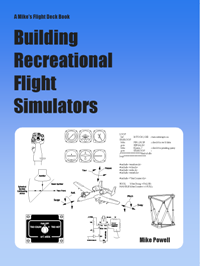
Trade paperback binding
Book overview
This is a broad ranging introduction to building a flight simulator for recreational use. It touches upon most aspects of simulator building with the common thread of improving the flight simulation experience. Each topic is presented in terms of what it can do to enhance the illusion of flight and deepen the sense of immersion. This provides a means for prioritizing where one’s time and hard earned cash should go.
There's a chapter by chapter description farther down the page. You can also read a sample. (PDF)
The book is intended for hobbyists, and takes a strong hands-on approach. There are many projects, both large and small. However, even the most enthusiastic DIY-er, will occasionally want to buy rather than build. I feel it is important to present at least some information about purchase options. (From other vendors, not me!) This is something of a risk. Our hobby is small and does not support many vendors. Frequently, new vendors learn the hard way and vanish overnight. Portions of the book might rapidly go out of date. Nonetheless, making the reader aware of options other than building seems valuable.
Circuit Boards and Micro Controller Files.
A number of the projects in the book incorporate electronics. It's not necessary to have circuit boards for these projects, but it sure is nice. I've posted the board design files on the BRFS Support page. I've also posted the hex files I used to program the PIC micro controllers buried in the middle of the electronics. You may use these files for free for non-commercial purposes on an as-is basis.
Reviews and Comments
If you would like to read what others have say about this book, check out these reviews and comments:
- Trevor Hale reviews it at MyCockpit.
- John "jmig" comments on it at MyCockpit.
Caveat
This is a challenging hobby. It's exciting. It's rewarding. It's fascinating. It's many things, but it is not easy.
Building Recreational Flight Simulators covers as much of the hobby as I could stuff into 608 pages. Many topics are illustrated by projects. Each project is documented with dimensioned drawings, flowcharts, commented listings, and circuit board artwork, as appropriate. To make full use of this book you'll need to have skills for, or learn a bit about, building with wood, metal, and plastic; programming; and electronics.
Comments?
I am open to comments, observations, criticism and suggestions. If you see shortcomings in the book, please drop me a note at "book2comments" (at) "mikesflightdeck.com". Thanks.
Introduction
This not only introduces the book’s structure, but also makes the case for building a home sim. As fantastic as today’s flight simulation applications are (and they are indeed fantastic!), the flight sim experience is limited by the device(s) employed by the user. The application creators employ a virtual warehouse of special tools to build the application, but the user experiences the result on what is basically a general-purpose computer. Maximizing the flight simulation experience calls for a specialized device on the user’s end. It’s called a home flight simulator.
Recreational Flight Simulation
This chapter is an introduction to the recreational flight simulation hobby. It distinguishes recreational FS from commercial FS by comparing the goals of each. Commercial FS supports training, research, and development. Recreational FS strives to deliver an experience. There's much overlap, but recognizing the different goals leads to better prioritization of limited resources when developing a home sim.
The chapter provides an overview of the major elements of simulator and how each contributes to the FS experience. It concludes with a list of skills typically called on for an FS project.
Joysticks
"Joysticks" addresses the quintessential flight control. It begins by listing and defining the general characteristics to consider when simulating a joystick. It then describes the in flight control feel of four representative real joysticks: a basic non-assisted joystick, rotary wing joysticks, commercial service sidestick controller, and military service sidestick controller. The chapter concludes with a detailed project about making a floor mounted stick (mostly) using readily available materials from a home building supply store, and perhaps Ebay. This project demonstrates the use of inexpensive Hall sensors as position sensors.

Control Yokes
No coverage of flight controls for simulators would be complete without addressing control yokes. A big issue for do-it-yourself hobby flight simmers is that control yokes are more complex. The mechanical linkages for even a single yoke are somewhat mysterious. All that and more will be covered in this chapter.
The chapter project is a general aviation style control yoke constructed mostly from materials available through home building supply sources. The bearings that support the control tube are standard mounted ball bearings from an on line industrial parts supplier. The potentiometers that do the control position sensing are from an electronics parts house.

Pedals Pedals
are somewhat in short supply in the sim world, yet are key elements in flying. The flight sim applications fudge it if there isn’t a set on the computer, but the lack is a significant distraction. If you’re looking for a better flight sim experience, there is no substitute for a proper set of pedals. That said, just what is a proper set of pedals? Should they move in a linear motion? How far should they move? Does the shape matter? And what are toe brakes, anyway? Here is the first prototype for the anti-torque pedal project.

Engine Controls
Engine controls are an important part of the sim experience. These are things that you physically interact with, so they have the potential for making a great contribution. Even a very basic set is a step up from using the keyboard. Adding more detail and functionality to controls in your simulator deepens the illusion and adds to the experience.
This chapter includes an overview of the variety of engine controls that exist in real aircraft. It provides links to sources of addition information as well as a list of vendors for simulator engine controls.

Position and Force Sensors
Position sensors are devices that translate the physical movement of flight and engine controls into something useable by the simulation computer. Potentiometers are moderately reliable, cost effective position sensors, and the chapter starts by looking into them in detail.
Other types of positions sensors may be better choices in some applications. For example, a rotary Hall effect sensor can be used in applications that would wear out a potentiometer’s sliding electrical contact.
The linear variable differential transformer, or LVDT, is useful in application having physical movement that is too small to effectively use a potentiometer.
Some controls respond to the applied force rather than strictly to their position. The Falcon side stick control is force activated. Although a brake pedal may move through a large arc, braking force is more directly related to the force applied to the pedal at the end of its motion when the brake pads have finally made contact with the rotors. When it comes to developing these sorts of controls for a simulator, it's nice to have some sort of sensor that let's you measure force. Load cells are just this sort of sensor, and this chapter has a section describing them.
Finally, the synchro control transformer is a rotary position sensor used in many aerospace applications. If you want to use surplus military or commercial avionics this will give you some useful background info.
Pictured below is part of the chapter LVDT project. This is the signal conditioner that generates the signal that excites the LVDT, and detects and amplifies the returned signal. The design calls for low cost, commonly available parts. I think the most expensive parts are the two trim pots, at maybe a dollar and a half each. The chips are about $0.60. Resistors, at least if you buy in quantity, are a few cents each. The board design is single sided making it easier for those who like to make their own boards.

I/O Options
Ultimately you need a connection between the simulation computer and the various elements that make up the simulator flight deck or cockpit. This chapter describes the I/O requirements of simulator components. You need to understand the requirements before you can plan a strategy, and this chapter overviews your options. A large section puts this theoretical coverage into practice by laying out an I/O system for a single-engine sim. The next section describes the approach taken for the I/O system used by several of the book projects. From a bits-per-second view, the vast majority of data I/O is already handled by system resources like the video and sound cards. But what about radio heads, DIY instruments, and A/C system switches? Certainly you could use various purchased USB modules, but if you want to go the DIY route there are a couple of projects: an RS-232 to RS-485 I/O bus adapter and a channel arbitrator that allows multiple devices to peacefully share a single com port.
This is the RS-232 to RS-485 I/O bus adapter:
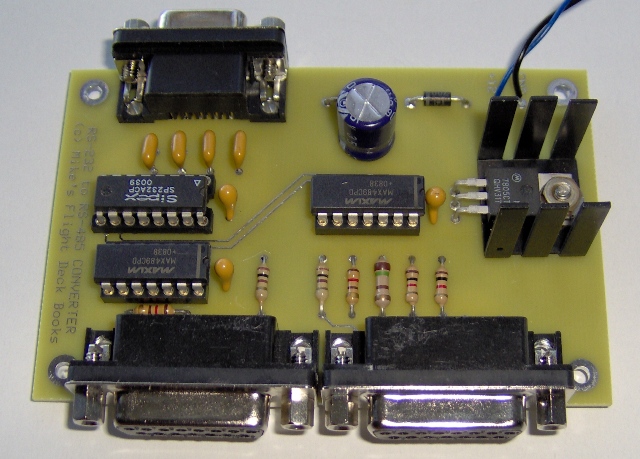
And here's a picture of the arbitrator:

Computer Drawn Instruments
Adding an instrument panel to a home simulator that is separate from the scenery display device greatly improves the flight illusion. Doing so can be an expensive challenge for someone starting in the hobby. This chapter describes a relatively easy and low cost approach based on using computer rendered instruments on a separate monitor. You can use the stock panels in MSFS, or you can roll your own. Either approach will add to the flight illusion and boost the feeling of immersion.

Using Real Instruments
Using salvaged instruments that have actually been installed in an operating aircraft adds a feeling of realism that is hard to beat. Some instruments can be used in a simulator setting, and some, sadly, can only act as a source of parts. This chapter overviews the major classes of instruments and explains what can be used and how. It includes a project for interfacing some the synchro-based real instruments.
The drawing below is one of many that illustrate the inner workings of typical aircraft instruments.
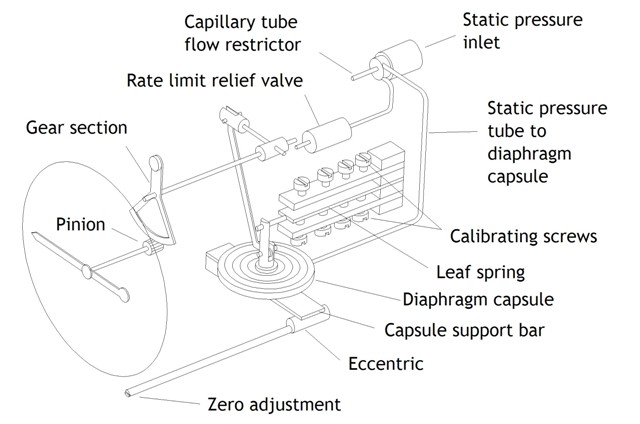
The project for this chapter is the digital to synchro adapter pictured below.

DIY Instruments
Instruments add a pleasing visual impact of functional complexity to the simulator, particularly so if they are steam gauge style indicators that swing real pointers and have internal lighting. This chapter overviews air-core movements, RC servos and stepping motors as workable approaches to simulating flight and engine instrumentation. There are two projects, a basic stepping motor based gauge, and a LED based, dual side-by-side set of engine gauges.

Scenery Display Systems
This chapter covers the basics of how we create a mental three dimensional world from the two dimensional images a simulator application generates. It goes into what we should consider when displaying these 2D images to get the best effects. There is an overview of the approaches taken by commercial simulator display systems and some recommendations for setting up a display system at home.
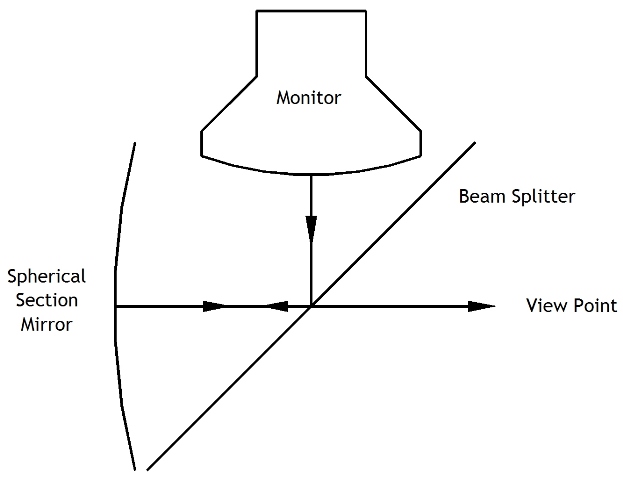
Panels
A proper array of panels is an important aspect in creating and supporting the flight illusion. If you are simulating a WWII bird you may be looking at a relatively small expanse of sheet metal sporting a crinkled black finish. If you’ve chosen a modern airliner for your project you’ll have significantly more panel area, and a fair portion will be magically backlit. This chapter will take you through some of the details of how flight rated panels are constructed and present a variety of techniques you can use when building your panels. It will touch on materials, colors, fonts and lighting.

Switch Inputs
Switches are a necessity! Having to bang on a keyboard to start an engine or retract the gear definitely fractures the flight illusion. This chapter covers some of the special switches found in aircraft and suggests a few, rather more affordable alternatives. It then get down to the business of interfacing switches to the simulation computer. After all, it's nice to have a landing gear lever that looking like a landing gear lever, but it's even better if something happens when it's moved.
The first project is a 16 switch input module, shown below. It communicates to the host PC through an RS485 party line connection. Using the RS232 to RS485 converter, and optionally the channel access arbitrator, from the Hardware I/O Options chapter, you can plug a bunch of these modules onto a single com port

The second project will be a radio head using a rotary encoder and an LCD character display. It will also talk to the host through an RS485 connection. The prototype is partially assembled and working.
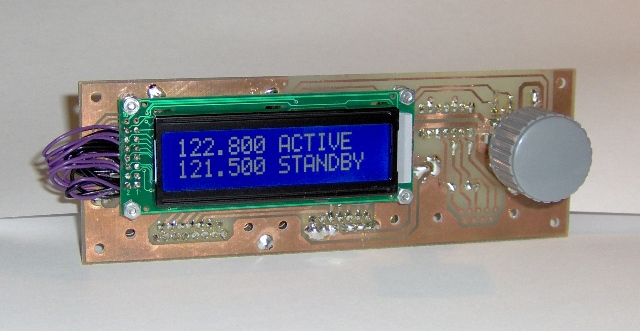
Warning and Status Lights
Indicator lights play varied roles in a simulator. The most important indicator lamps in a fixed gear G/A plane may be the marker beacon lights. A fighter likely has a master warning indicator that serves to get the pilot to look at the annunciator panel, a compact collection of many system indicator lamps. This chapter provides a background on lamps, both incandescent and LED. Projects include a dimmer, and Bell Jet Ranger and F-16 style warning panel.
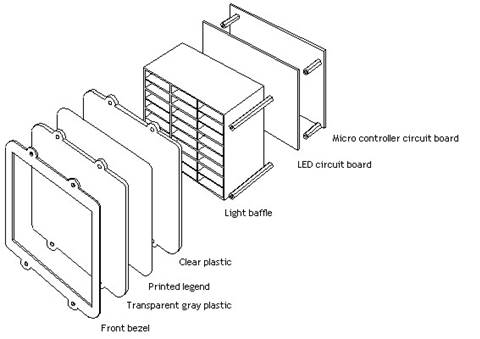

Interfacing with MSFS
The simulator flight deck is a silent museum diorama until it’s brought alive by a simulation application. That requires a high quality connection between the application and the various systems that make up your flight deck. The subject of this chapter is how to interface with Microsoft Flight Simulator.
MS FSX Deluxe ships with SimConnect, the official API for talking with the flight sim engine. Not surprisingly, the main focus of this chapter is on SimConnect; how to set it up, how to use MS VC++ Express to code against it, how to get data out of FSX and how to push data into it. The chapter will also give brief coverage to other I/O avenues.
Sound
Part of the flight experience is what you hear. The simulation developers have gone to a great deal of trouble to capture real flight sounds. There are also Internet based com systems such as Squawk Box and Team Speak that support ATC and team flying. This chapter describes your audio options.
There is project for the chapter, a power amplifier for driving a tactile transducer. The project incorporates a low pass filter so that only the lower frequencies drive the transducer.

(The power amplifier must be fastened to a heat sink during operation even though one is not shown in the picture.)
Motion & Force Cueing
Motion and force cueing are methods of creating the sensation of motion. Motion systems are likely the best known cueing systems. G-seats are less known, but have the advantage that the cues can be long lasting. Vision systems are covered in a separate chapter, but it's worth noting that they also supply motion cues and do so in synergy with the other two cueing systems. This chapter describes motion systems and G-seats, and lists resources for further detail.

Simulator Enclosures
An enclosure contributes to the flight sim experience by being the backdrop of the flight illusion. It is the element that joins the individual instrument panel, flight controls, engine controls, and scenery display into a connected whole. It deepens the feeling of immersion and suspension of disbelief becomes easier.
